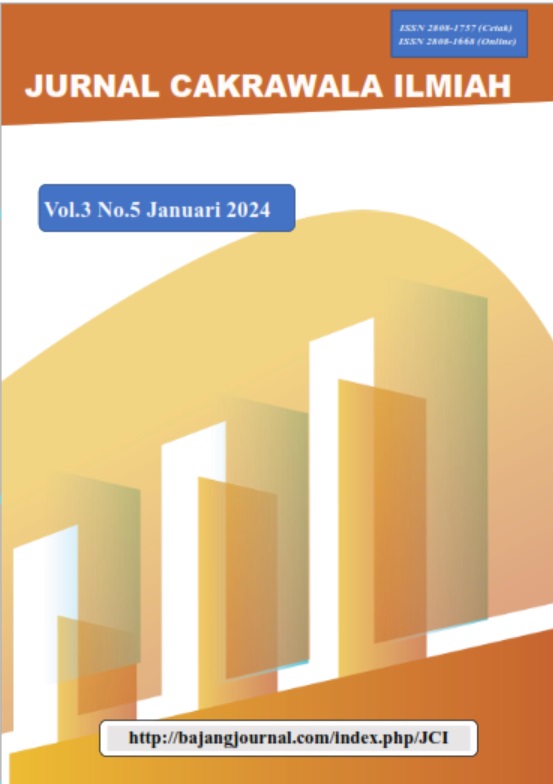PENGGUNAAN TEORI BELAJAR SIBERNETIKA SEBAGAI METODE PEMBELAJARAN BAHASA INDONESIA TINGKAT SEKOLAH DASAR
Keywords:
Indonesian, Learning Methods, Elementary School, Cybernetic TheoryAbstract
The purpose of writing this article is to fulfill the assignment for the Final Semester Examination for the Indonesian Language corse. Apart from that, another aim of writing this article is to be able to find out Indonesian language learning methods using learning media combined with learning methods based on a learning curriculum that is in accordance with the government based on cybernetic learning theory. In the educational context, cybernetic learning is often synonymous with feedback. This feedback from students allows teachers to find out what students' difficulties are in understanding the material and whether the material presented has been understood or not. To produce efficient learning, you don't just need to use one method, but need several methods. The learning methods applied in the classroom must be in accordance with the material and the teacher's disposition so that it will produce students who are creative, productive and have good and correct knowledge. According to Anggit Sri, et al (2013) revealed that a process of interaction between students and learning resources in a learning environment is an understanding of the learning process. In order for the process of acquiring science and knowledge, mastering skills, habits, and forming attitudes and beliefs in students, educators provide assistance in the form of learning. In other words, the process of helping students to learn well is called learning. Thus, this article was written in the hope that it can fulfill the Mid-Semester Exam assignment for the Indonesian language course and become a reference for every reader to be able to develop their abilities in developing a learning process based on cybernetic learning theory.
References
Admin. (2020, May 25). Pembelajaran Bahasa Indonesia. SMPN 234. https://smpn234.sch.id/blog/pembelajaran-bahasa- indonesia/
Ali, M. (2020). Pembelajaran Bahasa Indonesia Dan Sastra (BASASTRA) di Sekolah Dasar.
PERNIK : Jurnal Pendidikan Anak Usia Dini, 3(1), 35-44. https://doi.org/10.31851/pernik.v3i2.4839
Azkiah, H. (2021). Pendidikan Agama Islam Berwawasan Lingkungan ( Ecopedagogy ) di Madrasah Ibtidaiyah. Jurnal Pendidikan dan Sains, 3.
Bakti dan Sakdiah, S. dan H. (n.d.). PENGARUH PENERAPAN TEORI BELAJAR SIBERNETIK TERHADAP EFEKTIVITAS PEMBELAJARAN PAI DI SMP PUTRA JAYA STABAT KABUPATEN LANGKAT https://jurnal.uisu.ac.id/index.php/wahana/article/d ownload/4323/3101
dan Pembelajaran, D. P. (2019, June 28). Apa itu Pembelajaran?. Apa Itu Pembelajaran? https ://unida.ac.id/pembelaj aran/artikel/apa-itu- pembelajaran.html
Mariana,S.Pd., M.Sc., pH.D, N. (Ed.). (2018, January 1). Jurnal Review Pendidikan Dasar: Jurnal Kajian Pendidikan dan Hasil Penelitian . Jurnal Review pendidikan dasar: Jurnal Kajian pendidikan Dan Hasil Penelitian. https://journal.unesa.ac.id/index.php/PD
P, G. (2023, June 29). Teori Belajar Sibernatik: Pengertian, Kelebihan, Dan Penerapan. Gramedia Literasi. https://www.gramedia.com/literasi/teori- belajar-sibernatik/
Setiawan, R., Muhimmah, H. A., Subrata, H., Istiq’faroh, N., Abidin, Z., & Noerdiana, A. F. (2023). Metode Pembelajaran Bahasa Indonesia Yang inovatif tingkat Sekolah Dasar dengan teori Belajar Sibernetika. Jurnal Review Pendidikan Dasar: Jurnal Kajian Pendidikan Dan Hasil
Penelitian, 9(2), 117-122. https://doi.org/10.26740/jrpd.v9n2.p117-122
Suminar, T. (2019). Tinjauan Filsafati (Ontologi, Epistemologi Dan Aksiologi Manajemen Pembelajaran Berbasis Teori Sibernetik. Jurnal Edukasi, 3(2).
Suparlan, S. (2020). Pembelajaran Bahasa Indonesia di Sekoah Dasar. FONDATIA, 4(2), 245-258. https://doi.org/10.36088/fondatia.v4i2.897
Wikimedia Foundation. (2023, September 10). Belajar. Wikipedia. https ://id. m. wikipedia. org/wiki/Belaj ar
Downloads
Published
How to Cite
Issue
Section
License
Copyright (c) 2024 Jurnal Cakrawala Ilmiah

This work is licensed under a Creative Commons Attribution-NonCommercial 4.0 International License.
















